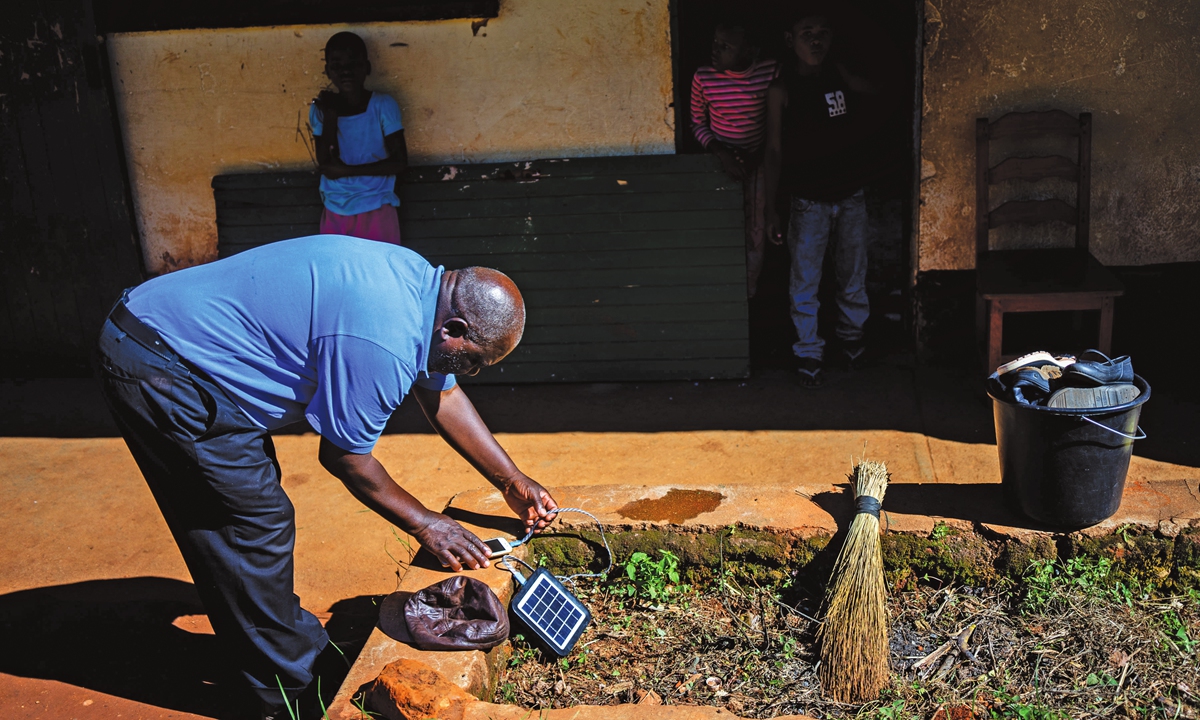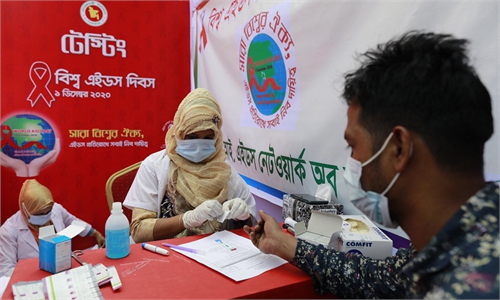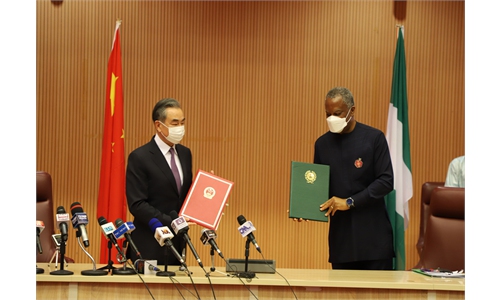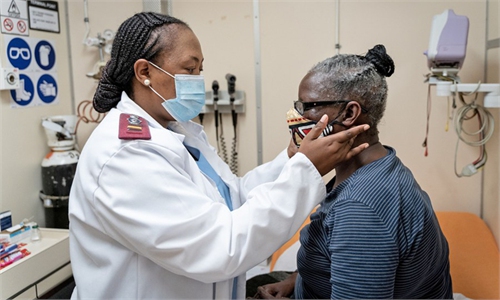With free buses and WhatsApp, southern Africa steps up storm preparation
Disaster aversion plans
When tropical storm Chalane threatened Zimbabwe and Mozambique in 2020, government authorities and aid agencies sprang into action, learning lessons from the death and destruction caused by cyclones in 2019.
Two consecutive cyclones - Idai in March 2019 and Kenneth in April 2019 - brought unusually heavy rains and high winds, causing more than 1,000 deaths across southern Africa, affecting nearly 4 million people.
In late December 2020, ahead of Chalane's arrival in Mozambique and eastern Zimbabwe, concerns mounted lives, property and infrastructure might be hit hard again.
In the end, the storm weakened and didn't cause widespread damage - but measures taken to ensure safety in advance suggested disaster prevention efforts have started to progress in the region.

In Zimbabwe, plans were implemented to protect people by dispatching information and evacuating them to shelters at designated schools, churches and public halls.
"We were fearful - undecided whether to sit out the storm in our homes or climb on buses to rescue zones," said Amos Myambo, a trader in eastern Zimbabwe's Chimanimani district, whose grocery shop was destroyed by Idai. "We chose rescue centers."
About 600 villagers were ferried for free by buses, tractors or lorries to assembly points, where they were registered and taken to evacuation centers according to an official from Chimanimani.
Crucially, about 150 people living in camps after Idai received shelter at two missionary schools, the Zimbabwe UN office noted.
In Beira and Sofala provinces in neighboring Mozambique, some residents in vulnerable areas moved to shelters near their homes, according to Susan Mbalu, spokeswoman for the Africa division of the International Federation of Red Cross and Red Crescent Societies.
The Mozambique Red Cross provided advance warning of the storm to locals, as it usually does, but went a step further, providing training and kit distribution to reinforce homes and schools ahead of Chalane.
Support was provided after weather forecasts triggered emergency funding for what the Red Cross calls "early action" amid a potential disaster.
The roofs and walls of 210 huts in camps for people resettled after previous weather disasters were reinforced with tarpaulins, plastic sheeting and sand piles, said Mbalu.
This measure, enacted 72 hours before the storm, was deployed in Buzi district, south of Beira, where more than half the province's vulnerable population lives, she added.
Despite efforts, the International Organization for Migration said 4,940 families at resettlement sites had tents and shelters destroyed or partially destroyed by Chalane, requiring help for the rest of the rainy season.
WhatsApp to the rescue
In Zimbabwe, before the storm's arrival, technology was used to dispatch warning messages, adapted to different communities, to members of the public via short-wave radio, Twitter, Facebook and WhatsApp.
Before Idai in 2019, standard advice given by civil defense authorities was to move to highland areas to avoid flooding.
"This was tragically unhelpful," remembered Caznet Majoka, a math teacher. "In Chimanimani district... it was in the highlands where properties and lives were flattened by muddy waters."
But with Chalane, officials urged residents to board buses to shelters.
They relayed messages in local languages like Shona with bullet-point lists on preparing for heavy rains, noted Majoka, who traveled 50 kilometers to a rescue center. "English could confuse rural residents," he added. Authorities using technology to send hourly updates and maps showing where people could wait out the storm was effective, thanks to the popular WhatsApp.
WhatsApp accounts for nearly 50 percent of all internet activity in Zimbabwe as it's easily installed on smartphones and uses little data.
Chenjerai Gunda, an artisanal gold-miner in Chimanimani, where risks of landslides exist due to deforestation, checked charts and weather updates on his phone every few hours several days before the storm.
He relied on WhatsApp to evacuate his wife and five children to a center in time.
"You don't need strong signal to receive or send warnings," he said. But use of cellphone-based messaging was not without hiccups. Majoka, the math teacher, said "fake news" and misinformation was also circulating. Thieves distorted WhatsApp messages to ensure villages were empty so they could loot small grocery shops, he said.
Some residents who realized this decided to stay home, including Skanyi Ngorima, who keeps 30 goats in Chikukwa village in eastern Zimbabwe. "Thieves would feast on my livestock under the cover of the storm," he said.
Fortunately, as Chalane weakened, residents returned home quickly in Zimbabwe and Mozambique.
Law, data
Environmental lawyer Lenin Chisaira, founder of Harare nonprofit Advocates4Earth, said civil protection officers could use the law to temporary possess land and property during storms to prevent people from staying in dangerous conditions.
David Gwenzi, assistant professor of geospatial science at California's Humboldt State University, who grew up in eastern Zimbabwe, said evacuations were a good first step. But greater disaster prevention will be needed as storms intensify with climate change, he added, urging African weather services to build partnerships with richer countries so they can access data providing better advance warnings of climatic weather extremes.
"Just like hurricanes in the southeastern US, tropical cyclones are going to frequent Mozambique and Zimbabwe because global warming is transforming seasonal rains into dire storms," Gwenzi told Reuters.
Two consecutive cyclones - Idai in March 2019 and Kenneth in April 2019 - brought unusually heavy rains and high winds, causing more than 1,000 deaths across southern Africa, affecting nearly 4 million people.
In late December 2020, ahead of Chalane's arrival in Mozambique and eastern Zimbabwe, concerns mounted lives, property and infrastructure might be hit hard again.
In the end, the storm weakened and didn't cause widespread damage - but measures taken to ensure safety in advance suggested disaster prevention efforts have started to progress in the region.

A man sets his phone for charge on a portable solar panel at Ngangu secondary school where families displaced by Cyclone Idai are sheltered in Chimanimani, Zimbabwe on March 21, 2019. Photo: AFP
In Zimbabwe, plans were implemented to protect people by dispatching information and evacuating them to shelters at designated schools, churches and public halls.
"We were fearful - undecided whether to sit out the storm in our homes or climb on buses to rescue zones," said Amos Myambo, a trader in eastern Zimbabwe's Chimanimani district, whose grocery shop was destroyed by Idai. "We chose rescue centers."
About 600 villagers were ferried for free by buses, tractors or lorries to assembly points, where they were registered and taken to evacuation centers according to an official from Chimanimani.
Crucially, about 150 people living in camps after Idai received shelter at two missionary schools, the Zimbabwe UN office noted.
In Beira and Sofala provinces in neighboring Mozambique, some residents in vulnerable areas moved to shelters near their homes, according to Susan Mbalu, spokeswoman for the Africa division of the International Federation of Red Cross and Red Crescent Societies.
The Mozambique Red Cross provided advance warning of the storm to locals, as it usually does, but went a step further, providing training and kit distribution to reinforce homes and schools ahead of Chalane.
Support was provided after weather forecasts triggered emergency funding for what the Red Cross calls "early action" amid a potential disaster.
The roofs and walls of 210 huts in camps for people resettled after previous weather disasters were reinforced with tarpaulins, plastic sheeting and sand piles, said Mbalu.
This measure, enacted 72 hours before the storm, was deployed in Buzi district, south of Beira, where more than half the province's vulnerable population lives, she added.
Despite efforts, the International Organization for Migration said 4,940 families at resettlement sites had tents and shelters destroyed or partially destroyed by Chalane, requiring help for the rest of the rainy season.
WhatsApp to the rescue
In Zimbabwe, before the storm's arrival, technology was used to dispatch warning messages, adapted to different communities, to members of the public via short-wave radio, Twitter, Facebook and WhatsApp.
Before Idai in 2019, standard advice given by civil defense authorities was to move to highland areas to avoid flooding.
"This was tragically unhelpful," remembered Caznet Majoka, a math teacher. "In Chimanimani district... it was in the highlands where properties and lives were flattened by muddy waters."
But with Chalane, officials urged residents to board buses to shelters.
They relayed messages in local languages like Shona with bullet-point lists on preparing for heavy rains, noted Majoka, who traveled 50 kilometers to a rescue center. "English could confuse rural residents," he added. Authorities using technology to send hourly updates and maps showing where people could wait out the storm was effective, thanks to the popular WhatsApp.
WhatsApp accounts for nearly 50 percent of all internet activity in Zimbabwe as it's easily installed on smartphones and uses little data.
Chenjerai Gunda, an artisanal gold-miner in Chimanimani, where risks of landslides exist due to deforestation, checked charts and weather updates on his phone every few hours several days before the storm.
He relied on WhatsApp to evacuate his wife and five children to a center in time.
"You don't need strong signal to receive or send warnings," he said. But use of cellphone-based messaging was not without hiccups. Majoka, the math teacher, said "fake news" and misinformation was also circulating. Thieves distorted WhatsApp messages to ensure villages were empty so they could loot small grocery shops, he said.
Some residents who realized this decided to stay home, including Skanyi Ngorima, who keeps 30 goats in Chikukwa village in eastern Zimbabwe. "Thieves would feast on my livestock under the cover of the storm," he said.
Fortunately, as Chalane weakened, residents returned home quickly in Zimbabwe and Mozambique.
Law, data
Environmental lawyer Lenin Chisaira, founder of Harare nonprofit Advocates4Earth, said civil protection officers could use the law to temporary possess land and property during storms to prevent people from staying in dangerous conditions.
David Gwenzi, assistant professor of geospatial science at California's Humboldt State University, who grew up in eastern Zimbabwe, said evacuations were a good first step. But greater disaster prevention will be needed as storms intensify with climate change, he added, urging African weather services to build partnerships with richer countries so they can access data providing better advance warnings of climatic weather extremes.
"Just like hurricanes in the southeastern US, tropical cyclones are going to frequent Mozambique and Zimbabwe because global warming is transforming seasonal rains into dire storms," Gwenzi told Reuters.



